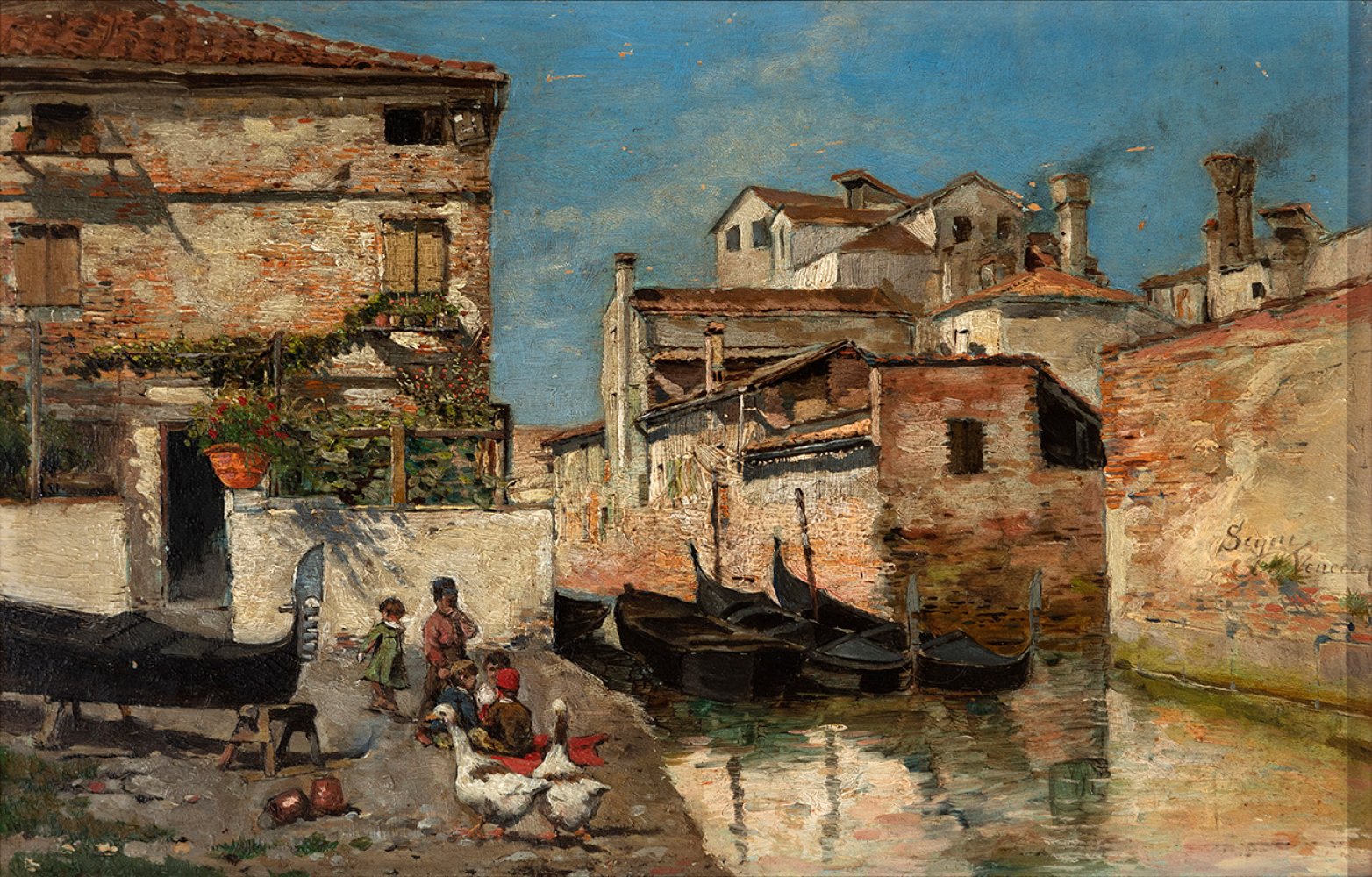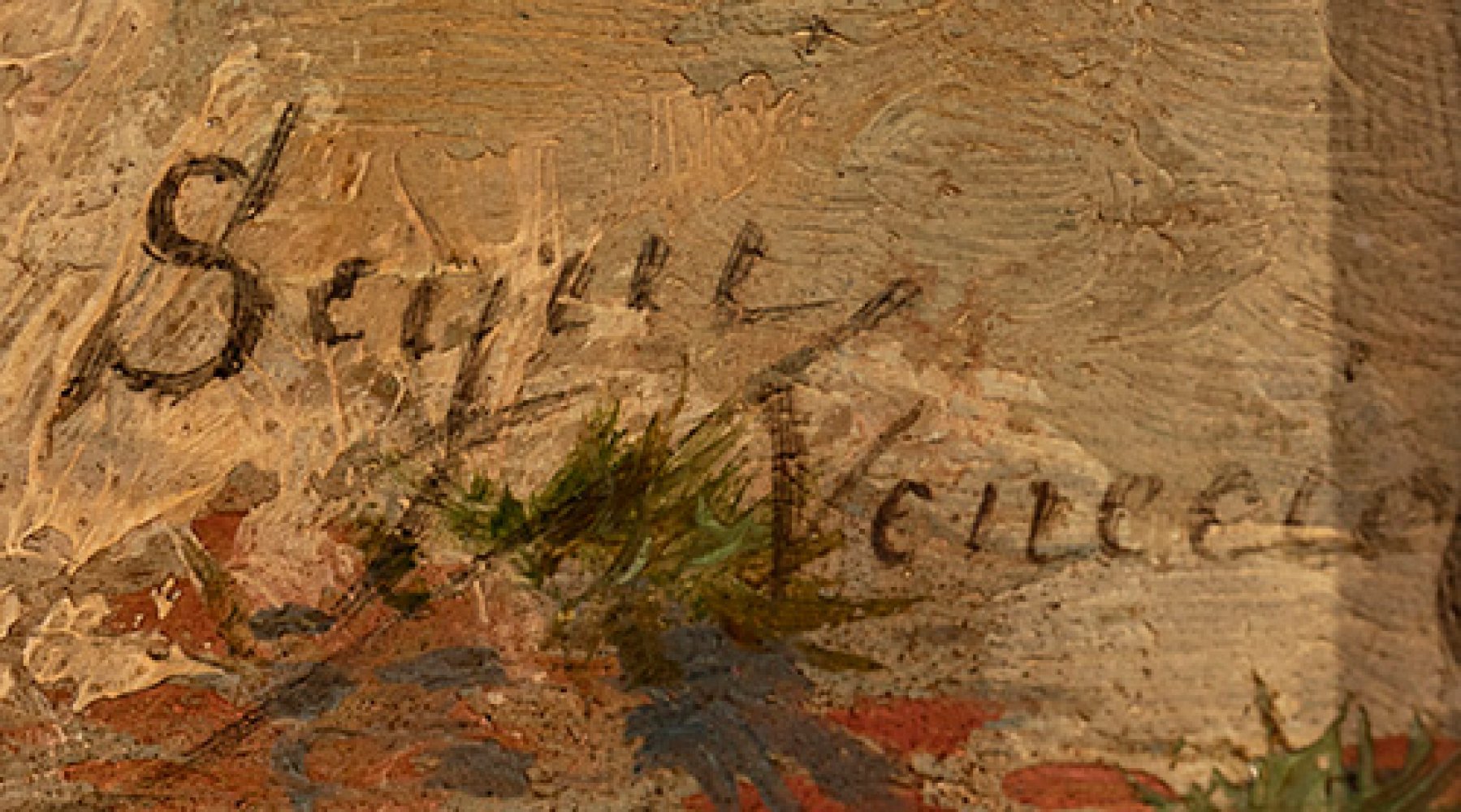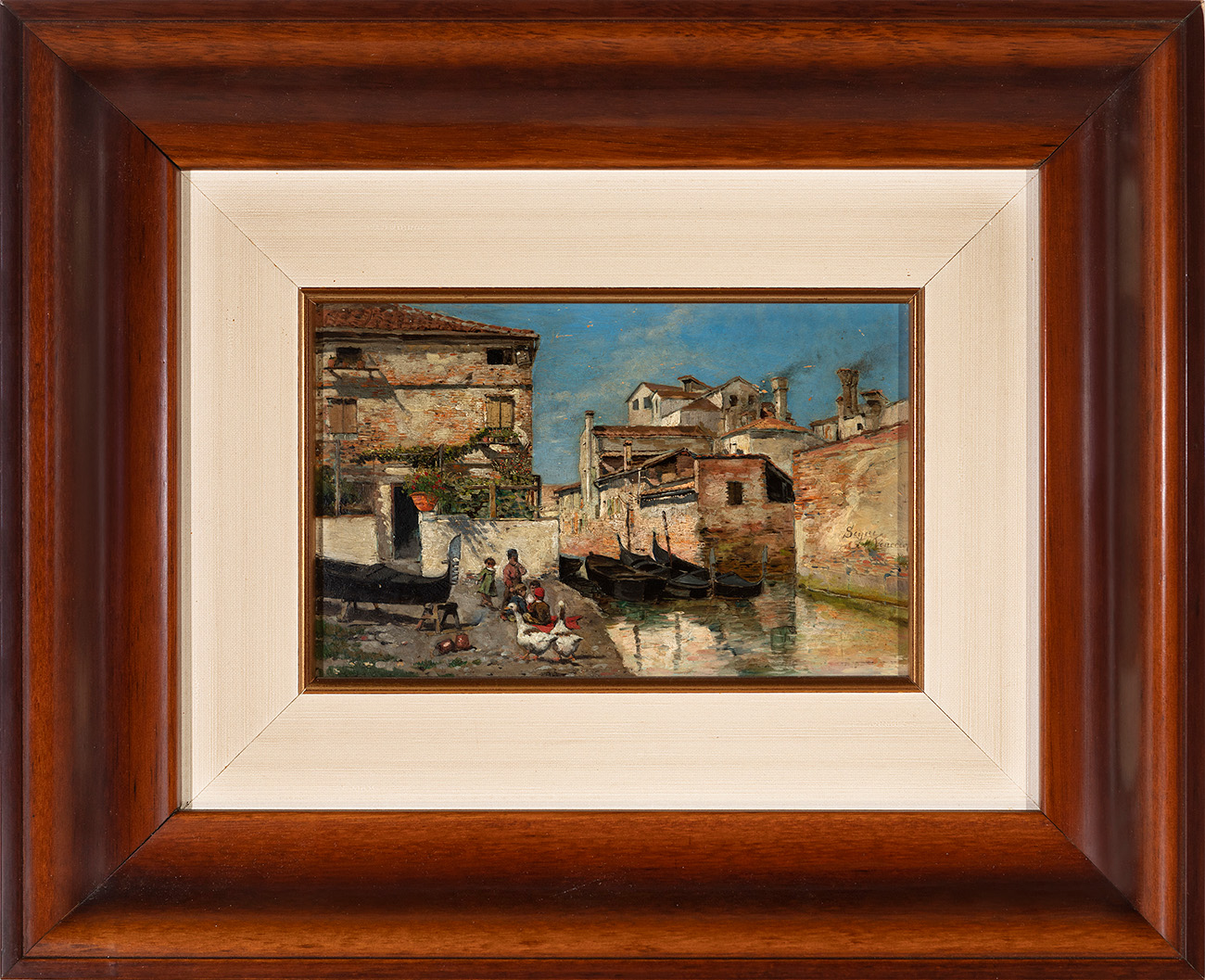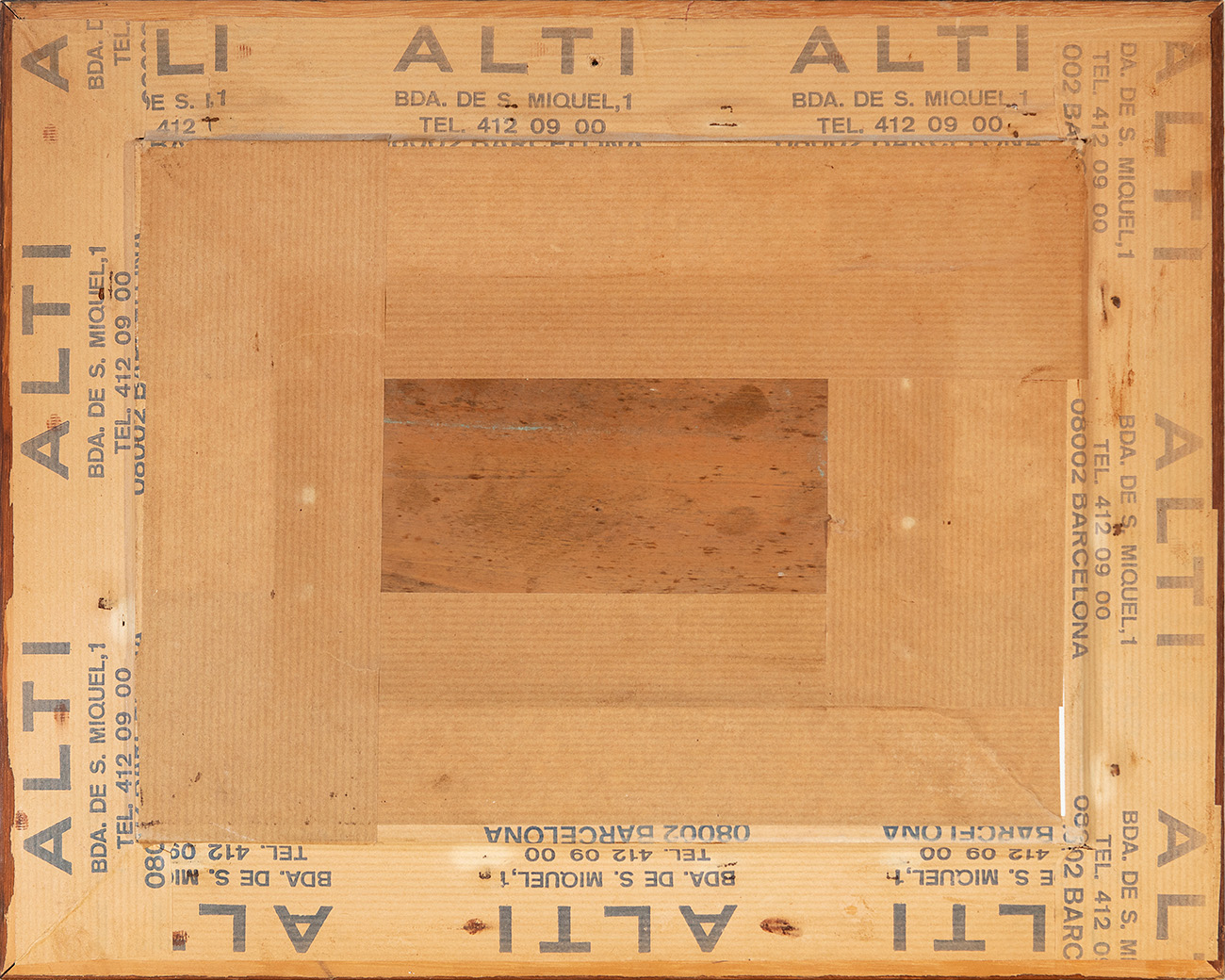33
MAMERTO SEGUÍ ARECHAVALA (Bilbao, 1862 - 1908)."Venice".Oil on panel.Signed and located in the right
1/4
Description
MAMERTO SEGUÍ ARECHAVALA (Bilbao, 1862 - 1908).
"Venice".
Oil on panel.
Signed and located in the right margin.
It presents losses in the pictorial layer.
Measurements: 13 x 20,5 cm; 32 x 39 cm (frame).
Mamerto Seguí immortalizes in this work a corner of Venice that moves away from the bustle and the classic ducal buildings that the painters of this time used to paint. Instead he depicts a secluded scene with a group of children playing by the canal.
A painter of landscapes, mansions, genre and oriental themes, Mamerto Seguí studied at the Schools of Fine Arts in Madrid and Barcelona, and subsequently travelled to Rome on numerous occasions. He combined his artistic practice with painting, which he practised first as a teacher of ornamental drawing at the Bilbao School of Arts and Crafts (1887) and from 1891 in different schools and official institutes. In 1903 he temporarily took over the classes of his colleague Anselmo Gómez, who was to finish the ceilings of the Palacio de la Diputación. Throughout his career Seguí took part in the following official exhibitions: the Provincial Exhibition of Vizcaya, held in Bilbao in 1882, and the National Fine Arts Exhibitions of 1884, 1887, 1890, 1897 and 1901. In the Vizcaya Provincial Exhibition his painting "Zamácola dictando a sus escribientes" ("Zamácola dictating to his scribes") won him a silver medal, and he was also awarded a silver medal in the National Exhibition: third medal in the 1884 exhibition for "Idilio", and he won the same award again later for "La preferida" ("The Preferred"). His work "Una boda" ("A Wedding") was also awarded a prize at the Basque festivals in Guernica, a canvas that was later exhibited at the Salón Velasco in Bilbao. In recent years, Mamerto Seguí's work has taken part in exhibitions such as the Basque art exhibition held at the Sala Garibai-Kutxa in San Sebastián in 1995. He is currently represented in the Museum of Euskal Herria.
During the second half of the 19th century, Spanish painters achieved a position in Rome never before attained by any other type of artist. The presence of Eduardo Rosales and Mariano Fortuny in the Eternal City, from 1857 and 1858 respectively, was a milestone in the development of Spanish painting. The technical advances made by these two painters from the 1860s onwards, as well as their international successes, encouraged their peers and artists of the following generations to move to Italy. According to a prominent Italian critic of the time, Diego Angeli, in "Le cronache del Caffè Greco", the Spaniards, during the period 1865-1885, were the arbiters of the Roman painting scene, to the extent that the most exclusive salons opened their doors to them.
It was they who monopolised most of the foreign art market, to the point of encouraging Italian artists to create new schools to counteract Spanish success. The so-called "Spanish School of Rome" was one of the most brilliant periods of Spanish art.
"Venice".
Oil on panel.
Signed and located in the right margin.
It presents losses in the pictorial layer.
Measurements: 13 x 20,5 cm; 32 x 39 cm (frame).
Mamerto Seguí immortalizes in this work a corner of Venice that moves away from the bustle and the classic ducal buildings that the painters of this time used to paint. Instead he depicts a secluded scene with a group of children playing by the canal.
A painter of landscapes, mansions, genre and oriental themes, Mamerto Seguí studied at the Schools of Fine Arts in Madrid and Barcelona, and subsequently travelled to Rome on numerous occasions. He combined his artistic practice with painting, which he practised first as a teacher of ornamental drawing at the Bilbao School of Arts and Crafts (1887) and from 1891 in different schools and official institutes. In 1903 he temporarily took over the classes of his colleague Anselmo Gómez, who was to finish the ceilings of the Palacio de la Diputación. Throughout his career Seguí took part in the following official exhibitions: the Provincial Exhibition of Vizcaya, held in Bilbao in 1882, and the National Fine Arts Exhibitions of 1884, 1887, 1890, 1897 and 1901. In the Vizcaya Provincial Exhibition his painting "Zamácola dictando a sus escribientes" ("Zamácola dictating to his scribes") won him a silver medal, and he was also awarded a silver medal in the National Exhibition: third medal in the 1884 exhibition for "Idilio", and he won the same award again later for "La preferida" ("The Preferred"). His work "Una boda" ("A Wedding") was also awarded a prize at the Basque festivals in Guernica, a canvas that was later exhibited at the Salón Velasco in Bilbao. In recent years, Mamerto Seguí's work has taken part in exhibitions such as the Basque art exhibition held at the Sala Garibai-Kutxa in San Sebastián in 1995. He is currently represented in the Museum of Euskal Herria.
During the second half of the 19th century, Spanish painters achieved a position in Rome never before attained by any other type of artist. The presence of Eduardo Rosales and Mariano Fortuny in the Eternal City, from 1857 and 1858 respectively, was a milestone in the development of Spanish painting. The technical advances made by these two painters from the 1860s onwards, as well as their international successes, encouraged their peers and artists of the following generations to move to Italy. According to a prominent Italian critic of the time, Diego Angeli, in "Le cronache del Caffè Greco", the Spaniards, during the period 1865-1885, were the arbiters of the Roman painting scene, to the extent that the most exclusive salons opened their doors to them.
It was they who monopolised most of the foreign art market, to the point of encouraging Italian artists to create new schools to counteract Spanish success. The so-called "Spanish School of Rome" was one of the most brilliant periods of Spanish art.
Auction Details
Shipping
T&Cs & Important Info
Ask seller a question
MAMERTO SEGUÍ ARECHAVALA (Bilbao, 1862 - 1908).
"Venice".
Oil on panel.
Signed and located in the right margin.
It presents losses in the pictorial layer.
Measurements: 13 x 20,5 cm; 32 x 39 cm (frame).
Mamerto Seguí immortalizes in this work a corner of Venice that moves away from the bustle and the classic ducal buildings that the painters of this time used to paint. Instead he depicts a secluded scene with a group of children playing by the canal.
A painter of landscapes, mansions, genre and oriental themes, Mamerto Seguí studied at the Schools of Fine Arts in Madrid and Barcelona, and subsequently travelled to Rome on numerous occasions. He combined his artistic practice with painting, which he practised first as a teacher of ornamental drawing at the Bilbao School of Arts and Crafts (1887) and from 1891 in different schools and official institutes. In 1903 he temporarily took over the classes of his colleague Anselmo Gómez, who was to finish the ceilings of the Palacio de la Diputación. Throughout his career Seguí took part in the following official exhibitions: the Provincial Exhibition of Vizcaya, held in Bilbao in 1882, and the National Fine Arts Exhibitions of 1884, 1887, 1890, 1897 and 1901. In the Vizcaya Provincial Exhibition his painting "Zamácola dictando a sus escribientes" ("Zamácola dictating to his scribes") won him a silver medal, and he was also awarded a silver medal in the National Exhibition: third medal in the 1884 exhibition for "Idilio", and he won the same award again later for "La preferida" ("The Preferred"). His work "Una boda" ("A Wedding") was also awarded a prize at the Basque festivals in Guernica, a canvas that was later exhibited at the Salón Velasco in Bilbao. In recent years, Mamerto Seguí's work has taken part in exhibitions such as the Basque art exhibition held at the Sala Garibai-Kutxa in San Sebastián in 1995. He is currently represented in the Museum of Euskal Herria.
During the second half of the 19th century, Spanish painters achieved a position in Rome never before attained by any other type of artist. The presence of Eduardo Rosales and Mariano Fortuny in the Eternal City, from 1857 and 1858 respectively, was a milestone in the development of Spanish painting. The technical advances made by these two painters from the 1860s onwards, as well as their international successes, encouraged their peers and artists of the following generations to move to Italy. According to a prominent Italian critic of the time, Diego Angeli, in "Le cronache del Caffè Greco", the Spaniards, during the period 1865-1885, were the arbiters of the Roman painting scene, to the extent that the most exclusive salons opened their doors to them.
It was they who monopolised most of the foreign art market, to the point of encouraging Italian artists to create new schools to counteract Spanish success. The so-called "Spanish School of Rome" was one of the most brilliant periods of Spanish art.
"Venice".
Oil on panel.
Signed and located in the right margin.
It presents losses in the pictorial layer.
Measurements: 13 x 20,5 cm; 32 x 39 cm (frame).
Mamerto Seguí immortalizes in this work a corner of Venice that moves away from the bustle and the classic ducal buildings that the painters of this time used to paint. Instead he depicts a secluded scene with a group of children playing by the canal.
A painter of landscapes, mansions, genre and oriental themes, Mamerto Seguí studied at the Schools of Fine Arts in Madrid and Barcelona, and subsequently travelled to Rome on numerous occasions. He combined his artistic practice with painting, which he practised first as a teacher of ornamental drawing at the Bilbao School of Arts and Crafts (1887) and from 1891 in different schools and official institutes. In 1903 he temporarily took over the classes of his colleague Anselmo Gómez, who was to finish the ceilings of the Palacio de la Diputación. Throughout his career Seguí took part in the following official exhibitions: the Provincial Exhibition of Vizcaya, held in Bilbao in 1882, and the National Fine Arts Exhibitions of 1884, 1887, 1890, 1897 and 1901. In the Vizcaya Provincial Exhibition his painting "Zamácola dictando a sus escribientes" ("Zamácola dictating to his scribes") won him a silver medal, and he was also awarded a silver medal in the National Exhibition: third medal in the 1884 exhibition for "Idilio", and he won the same award again later for "La preferida" ("The Preferred"). His work "Una boda" ("A Wedding") was also awarded a prize at the Basque festivals in Guernica, a canvas that was later exhibited at the Salón Velasco in Bilbao. In recent years, Mamerto Seguí's work has taken part in exhibitions such as the Basque art exhibition held at the Sala Garibai-Kutxa in San Sebastián in 1995. He is currently represented in the Museum of Euskal Herria.
During the second half of the 19th century, Spanish painters achieved a position in Rome never before attained by any other type of artist. The presence of Eduardo Rosales and Mariano Fortuny in the Eternal City, from 1857 and 1858 respectively, was a milestone in the development of Spanish painting. The technical advances made by these two painters from the 1860s onwards, as well as their international successes, encouraged their peers and artists of the following generations to move to Italy. According to a prominent Italian critic of the time, Diego Angeli, in "Le cronache del Caffè Greco", the Spaniards, during the period 1865-1885, were the arbiters of the Roman painting scene, to the extent that the most exclusive salons opened their doors to them.
It was they who monopolised most of the foreign art market, to the point of encouraging Italian artists to create new schools to counteract Spanish success. The so-called "Spanish School of Rome" was one of the most brilliant periods of Spanish art.
31st August -19th & 20th Century Arts
Sale Date(s)
Venue Address
Aragón 346, Barcelona
Calle Velázquez 7, Madrid
Carrer de Cirilo Amorós 55, Valencia
Barcelona
08009
Spain
General delivery information available from the auctioneer
Setdart offers Worldwide shipping
PICK UP IN ROOM: You can come and pick up your lots in our offices (Barcelona, Madrid or Valencia). At the moment of the withdrawal, you will be able to accept the current conditions of the lot by means of a document that you will sign.
YOU CAN SEND ANOTHER PERSON TO PICK UP: This person must present a signed authorization that you can find in our web page by accessing from BUY AT SETDART- LOGISTICS-DOWNLOAD AUTHORIZATION DOCUMENT. You can also send an e-mail with the requested data in AUTHORIZATION DOCUMENT to admin@setdart.com
Important Information
25% buyer´s premium
21% buyer´s premium at www.setdart.com












